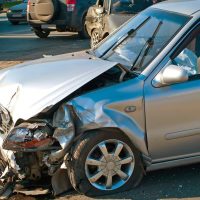Crumple Zones: Why Car Damage in an Accident Can Make the Accident Safer

How many times have you seen or driven by what looks to be a very bad accident—the cars in the accident just look like they have been devastated. The front end of the vehicles are all crushed in, and you think that must be an indication of the horrible nature of the accident.
Well, that’s not always true—in fact, the opposite is often true. It is often the case that the worse the damage to the cars appears to be, the safer the people inside the car are or were during the accident. That’s because of what is known as a crumple zone.
Why are Crumple Zones Safe?
Imagine a car that was hit from the front. The front end of the car is solid; it doesn’t crush, crumple, or go in at all on impact. That sounds super safe. But it’s not—because the impact of the accident gets transferred to the people inside the vehicle. In other words, the less the car crumples in, the more your body, inside the car, is thrust back and forth inside the vehicle.
Crumpling also allows your car to “slow down” the car that’s hitting it. Instead of your body absorbing all, for example, 35 miles per hour of a car that hits you from behind, by the time your car crumples, your body is only absorbing, say, only 15 miles per hour worth of car.
Today’s cars are designed to “cave in” on impact from the front or from the back. By doing this, the impact is absorbed by the car itself, and the passenger cabin and the occupants inside of it, aren’t moved nearly as much on impact.
The Science of Crumple Zones
Crumple zones are interesting scientific innovations. On the one hand, the car needs to crumple in, to absorb impact in an accident. But the car can’t entirely just crush in, otherwise it would not only intrude on the passengers inside, but could also end up damaging vital—and flammable—parts of the car. Car manufacturers have, in the past years, even relocated where the engine sits, so as to allow for safe crumpling on impact from the front.
Getting Juries to Understand Crumple Zones
Despite all this logic and the science behind it, Defendants in car accidents continue to argue to juries that damage to a car, correlates with damage or injuries to the people inside. Defendants will see a car that hardly looks damaged on impact (likely because the car has no crumple zones, or was hit in a way that it didn’t crumple in), and argue that the occupants inside the car couldn’t have been injured on such a “minor” impact.
This argument, though illogical, can persuade a jury, unless your injury attorney knows about the science of crumple zones, and can explain the logic to a jury.
Injured in a car accident? Let us help you explain your case to a jury. Call the Knoxville personal injury attorneys at Fox Farley Willis & Burnette, PLLC, for help today.
Sources:
auto.howstuffworks.com/car-driving-safety/safety-regulatory-devices/crumple-zone.htm
youtube.com/watch?v=YO2vxMIqg8











